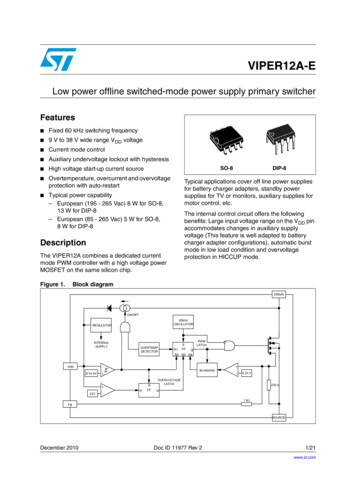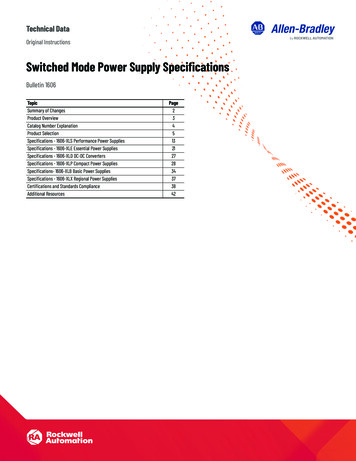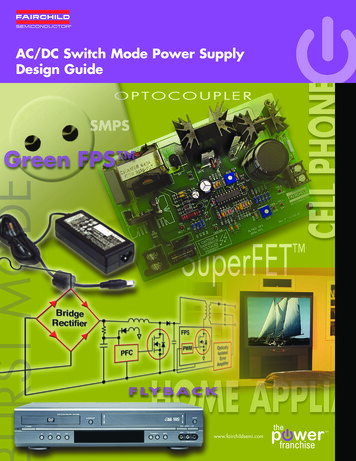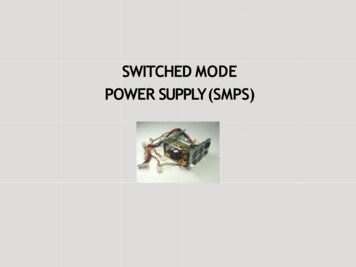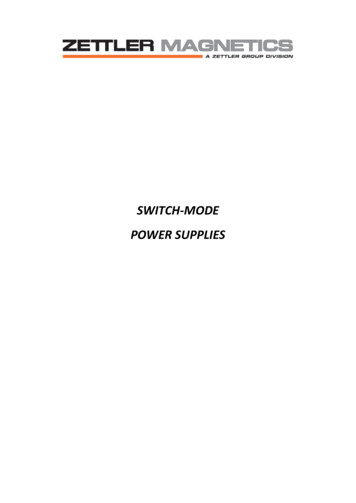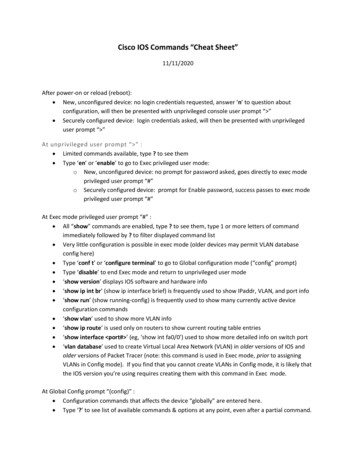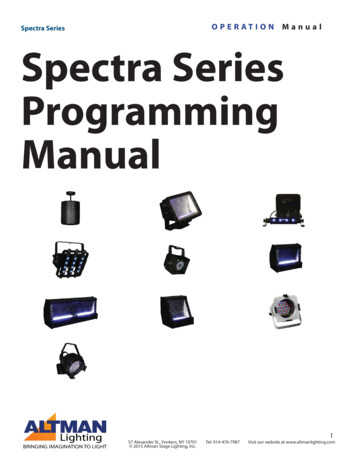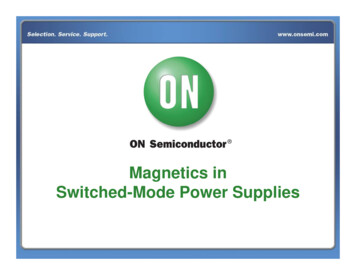
Transcription
Magnetics inSwitched-Mode Power Supplies
Agenda 2Block Diagram of a Typical AC-DC Power SupplyKey Magnetic Elements in a Power SupplyReview of Magnetic ConceptsMagnetic MaterialsInductors and Transformers
Block Diagram of anAC-DC Power nsformerOutputCircuitsDCOutputs(to loads)
Functional Block DiagramInput FilterRectifierPFCL BusGPFCControl BusReturnNPower StageXfmrOutput Circuits 12 V, 3 A Bus5 V, 10 APWMControl 3.3 V, 5 A- BusReturnMagAmpReset4
TransformerXfmrCR2L3a CR312 V, 3 A-C5CR4L3b BusQ2CR55 V, 10 A-C6 BusReturn In forward converters, as in most topologies, the transformer simplytransmits energy from primary to secondary, with no intent of energystorage.Core area must support the flux, and window area must accommodatethe current. Area product. POAP Aw Ae K ΔB 543 cm 4f
Output Circuits Popular configuration for thesevoltages---two secondaries, withFrom 12 Va lower voltage output derived secondaryfrom the 5 V output using a magamp postregulator.From 5 VCR2L3a CR3CR4C5L3b secondaryCR5CR6C6CR8 CR7C7MagAmpReset65 V, 10 A-L4SR1 12 V, 3 A-Feedback to primary PWM is usually from the 5 V output,leaving the 12 V output quasi-regulated.3.3 V, 5 A-
Transformer (cont’d) Note the polarity dots.Xfmr– Outputs conduct while Q2 is on.– Secondary Vpeaks Bus Ns/Np Note the coupled output choke, L3.– Windings must have same turns ratiosas transformer, which is the same asoutput voltages plus diode drops ofCR3 and CR5. 7CR2L3a CR312 V, 3 A-C5CR4L3b BusQ2CR5C65 V, 10 A- BusReturnWith output chokes in continuous conduction, each output voltageis the average of its secondary voltage (neglecting diode drops).Therefore, each output voltage is its secondary peak voltage timesthe duty ratio of the primary bus voltage, Bus, (neglecting diodedrops and Q2’s ON voltage).
Review of Some Magnetic Concepts 8Units used in the design of magnetic componentsCurrent and magnetic fluxCharacteristics of magnetic materialsFaraday’s Law (the “transformer equation”)
Units and Their SymbolsSymbol 9DescriptionSI UnitsHBμFfield strengthflux densitypermeabilitymagnetomotive forceA-t/mtesla tinductancewinding turnsweber/t (Wb/t)A-t2/Wbhenry/t2ampere (A)henry (H)turn (t)Units named for famous people are not capitalized (ampere,henry, volt), but their symbols are (A, H, V).Always separate the value from the unit symbol (10 uH, not10uH)---it’s not an option.
Right-Hand RuleFlux Direction as a Result of Current Flow 10Wrap one’s right hand around a conductor with thumb pointing in thedirection of current flow. Fingers point in the direction of flux lines.
Material CharacteristicsBflux density in tesla (1 tesla 10,000 gauss)Slope B/H μ permeabilityAirμ(relative) 1Hmagnetic field strength in ampere turns / meter Bulk property of the materialH NI/le ampere turns per meter– Classic definition is amperes per meter (assumes only one turn)– le magnetic path length 11µ permeability, usually relative to air (µair 4 π 10-7 H/m)
Core Characteristicsφ B Aeflux in webers (1 weber 1 tesla square meter)Slope φ /F P permeance"Inductance Factor" in H / t2F H lemagnetomotive force in ampere turns Core with no winding. Material characteristics, with Ae and le added.– Ae core area, le effective magnetic path length– Common unit for the slope is “Inductance Factor,” usually given in nH / t212
Wound Coil CharacteristicsΝφflux turns in weber turns volt secondsSlope L inductance (henries)Icurrent in amperes 13Using volt-seconds and amperes, the wound component can beanalyzed easily by circuit engineers using time-domain analysis.
The “Transformer Equation”(Faraday’s Law)E 4 B Ae fN B in tesla, Ae in m2, f in Hz– Modern SI units 14The saturation flux density, Bmax, determines themaximum volts per turn that can be applied to a giventransformer or inductor winding at a given frequency.
Watch closely, now:Transformer Equation from Faraday’s LawΔΦE NΔtΦ B AeBΔBΔΦ ΔB Ae 2 B Ae11 1Δt T 22 fE ΔΦ1 2 B Ae 1 4 B Ae fNΔt2f 15Note: This applies to square waves (where Δt half of the period).
An Extremely Important FactE ΔΦ 4 B Ae fNΔt 16Unless the flux is changing, there will be no voltage.If the flux swings back and forth, so will the voltage.In order for there to be a net dc voltage, the flux must be continuallyincreasing.Therefore, our chances of inventing a magnetic rectifier are ZERO.The average voltage (dc) across a winding (neglecting windingresistance) is ALWAYS ZERO. This is one of the most useful factsin our bag of tools.
Popular MaterialsMaterial 17Permeability Bsat(relative)(tesla)Loss @ 0.1 T,100 kHz(mW/cm3)UsageFerrite(Mag. Inc. P)25000.580Power TransformersFilter Inductors (gapped)PFC Inductors (gapped)Ferrite(Mag. Inc. W)10,0000.42250EMI Filters(common-mode only)Molypermalloy(Mag. Inc. MPP)600.75340Filter InductorsPFC InductorsSendust(Mag. Inc. Kool-Mu)601850Filter InductorsPFC InductorsPowdered iron(Micrometals 52)751.43200Filter InductorsPFC Inductors80% Cobalt tape(Honeywell 2714A)100,0000.5590Mag. AmpsNote the wide range of permeability and power loss.
Inductors and Transformers Inductor operation (example: buck regulator) Conduction modes– Continuous mode– Critical conduction mode– Discontinuous mode The boost regulator Transformer operation– Flyback converter– Forward converter18
Buck Regulator(Continuous Conduction) Inductor current is continuous.– Vout is the average of the voltage atits input (V1).– Output voltage is the input voltagetimes the duty ratio (D) of theswitch.– When switch in on, inductor currentflows from the battery.– When switch is off, it flows throughthe diode.– Neglecting losses in the switchesand inductor, D is independent ofload current. A characteristic of buck regulatorsand its derivatives:– Input current is discontinuous(chopped), and output current iscontinuous (smooth).19i3i1v1Vin 15 VVout 5 VLoad(R)i2v1 0i1 0i2 0i30time
Buck Regulator(Critical Conduction)i3i1 Inductor current is stillcontinuous, but just“touches” zero as theswitch turns on again.– This is called “criticalconduction.” Output voltage is still equalto the input voltage timesD.v1Vin 15 VLoad(R)i2v1 0i1i2i30time20Vout 5 V
Buck Regulator(Discontinuous Conduction) In this case, the current in theinductor is zero during part ofeach period.Output voltage is still (asalways) the average of v1.Output voltage is NOT the inputvoltage times the duty ratio (D)of the switch.While the load current is belowthe critical value, D varies withload current (while Voutremains constant).i3i1i2i1Vin 15 Vv1Load(R)i2v10i1i2i3time21Vout 5 V
Boost Regulator Output voltage is always greaterthan (or equal to) the inputvoltage.Input current is continuous, andoutput current is discontinuous(the opposite of a buckregulator).Relationship of the outputvoltage to the duty ratio, D, is notas simple as in the buckregulator. In the continuousconduction case, it is: 1 Vo Vin 1 D 22In this example, Vin 5,Vout 15, and D 2/3.i1i3Vout 15 Vv1Vin 5Vi2Load(R)Vout 15 VVin 5 Vv1 0i10i20i30time
Transformer (No Energy Storage)INΔΦOUT Ampere-turns of all windings sum to zero.– Right-hand rule applies to the applied current and the resulting flux.The opposite occurs on the output winding.23
Transformer (Energy Storage) 24This is a conventional flyback transformer.Energy is delivered to the magnetic core during the pulse applied to the primary.Energy is transferred from the core to the load during the remaining portion of the cycle.Ampere-turns of all windings do not sum to zero over each cycle when in continuousconduction mode. This is consistent with energy storage ( 1/2 L I2 ).
Transformer OperationIncluding Effect of Primary Inductancev0timeiiturns ratio:1:2i1i2i sec.v sec.Load (R)0v sec. 0 25i10i20i sec. 0This is an example of a “step-up” transformer (secondary voltage ishigher than the primary voltage).Transformer is shown as an ideal transformer, with its primary(magnetizing) inductance as an inductor in parallel with the primary.
Flyback TransformerReally a Multi-Winding Inductorturns ratio:i pri.1:2i sec.VoutVinv pri.v pri. 0v sec.Load (R)Voutv drain0v sec. 0i pri. 0time 26i sec. 0Here, the primary inductance is intentionally low, to determine thepeak current and hence the stored energy. When the primaryswitch is turned off, the energy is delivered to the secondary.Discontinuous conduction mode is shown in this example.
Forward Converter Transformerturns ratio:1:2i pri.Vinv pri. 0i1i2i3i sec.VoutLoad (R)v sec.iRESETv drain10v sec. 0i pri. 0i1Vout0iRESET 0v node 00i sec. 0i2timei3 270Primary inductance is high, as there is no need for energy storage.Magnetizing current (i1) flows in the “magnetizing inductance” and causescore reset (voltage reversal) after primary switch turns off.
Power Factor Correction Power Factor (PF) is a term describing the input characteristic of anelectrical appliance that is powered by alternating current (ac).It is the ratio of “real power” to “apparent power” or:Preal(v i )averaged over one cyclePF PapparentVrms Irms 28Where v and i are instantaneous values of voltage and current, and rmsindicates the root-mean-squared value of the voltage or current. Theapparent power (Vrms x Irms), in effect, limits the available outputpower.The boost regulator is the most popular topology chosen to shape theinput current to match the input voltage (usually a sine wave).
Boost Regulator Output voltage is always greaterthan (or equal to) the inputvoltage.Input current is continuous, andoutput current is discontinuous(the opposite of a buckregulator).Relationship of the outputvoltage to the duty ratio, D, is notas simple as in the buckregulator. In the continuousconduction case, it is: 1 Vo Vin 1 D 29In this example, Vin 5,Vout 15, and D 2/3.i1i3Vout 15 Vv1Vin 5Vi2Load(R)Vout 15 VVin 5 Vv1 0i10i20i30time
Design of the PFC Inductor Input: 90 – 264 Vac; Output: 400 VdcPout 120 W (into the output converter)Choose: Ripple current 0.5 A pp when input is 50% of the outputvoltage.Switching frequency f 130 kHz.Inductance required:– Note: Use V 200, since this represents the input at 200 V and the outputat 400 V.1200 V t2 130,000L 1.54 mH i pp0.530
Winding Losses in High-Frequency Magnetics Power loss in switched-mode magnetic components are significant andsometimes difficult to predict.– Analytically, they amount to three-dimensional field problems.– Winding losses are usually more troublesome than core losses. 31The skin effect --- current crowding in conductors at high frequencies --is well-known, but is not the worst part of the problem.Proximity effects --- due to fields induced by nearby conductors --- aremuch more significant, AND more difficult to predict.Early work, using sine waves, is inadequate to explain the losses withtypical waveshapes in switched-mode power supplies.A knowledge of the basic principles is essential in HF magnetics design.
Eddy Currents Skin effect is cause by eddy currents induced in a conductor by thecurrent in that conductor. Proximity effect is caused by eddy currents induced in a conductor bythe current in an adjacent conductor.EDDY CURRENTSKIN EFFECT32PROXIMITY EFFECT
Eddy Currents (cont’d) 33As in the earlier two-winding transformerexample, magnetic field is induced by thecurrent per the right-hand rule (dotted linesof flux).The flux causes eddy currents, analogous tothe secondary current in the transformer.
Skin Depth in Copper 34Example: At 100 kHz, skin depth is 0.2 mm radius of #26 wire.
Rac/Rdc vs. Diameter Example: If the diameter is 7 skin depths, Rac 2 Rdc.– At 100 kHz, this corresponds to # 15 wire (1.4 mm dia.).35
Proximity EffectNote Opposing CurrentsCURRENTS IN OPPOSITE DIRECTIONS At 100 kHz, with rectangular waveforms (high harmonic content),the proximity effect is MUCH more important than skin effect.36
Proximity EffectMultiple Parallel Wires 37This occurs when using copper wires in parallel in transformers andinductors.
MMF Diagrams 38Eddy current loss and energy stored in a field are proportional to H 2To design HF windings you must know what the field intensity (H) is.The mmf diagram is a very useful tool for determining H within awinding.F NI H leIn the following examples we assume le 1 so that F HEven when not used for computation, the mmf diagram is powerful toolfor arranging the winding structure to minimize loss and leakageinductance because it allows one to visualize the effect of differentwinding arrangements on the fields within a winding structureFor simplicity, in the following examples solenoidal fields will beassumed
H Diagram for a Single-Layer CoilE-E CoreH NI/le0 39H goes from 0 at outside to NI/le inside, then back to 0 outside.
Inductor with 4-Layer Winding4I3I2II0 40H increases with each layer, remains at 4 I within the coil, thendecreases with each layer and returns to 0 outside.Remember: Power loss is proportional to H2.
Design of the Main Transformer 41Most important: Determine the range of input voltage.In PFC-input power supplies, the max. is usually 400 V.The minimum input voltage to the transformer is usually a matter ofhow much holdup time is required---the time that the power supplycan continue to operate after an interruption of the input power.In ac-input power supplies, with or without PFC, there is an energystorage capacitor at the input of the converter.The design of this holdup feature requires the choice of thecapacitor value and the operating voltage range of the converter.The converter’s operating range sets the transformer design.
Holdup Time vs. Bus Voltage How much holdup time is achieved by allowing the bus voltage todecay to a given fraction of its initial value?Energy U extracted from thebus capacitor is11U C (V0 2 V12 )2Let V1 k V01Then U C V0 2 (1 k 2 )2 420.80.6U( k )0.40.200.40.50.60.7k0.80.9Note that half of the available energy has been extracted when thevoltage had decayed to 70.7% of its initial value.1
Example 43Pick 400 V for the nominal bus voltage.Use a 450 V bus capacitor, 500 V FETs in a two-transistor forward,half-bridge or full-bridge converter, or 900 V to 1000 V FETs in asingle-ended forward converter.Design for a final voltage of 60% (240 Vdc). Given a max. dutyratio of 45%, the nominal duty ratio will be 27%.This results in a minimum capacitor value of 0.4 uF per watt ofoutput power into the output power converter, for a holdup time of20 ms.
Detailsk V finalV0(122U P t C V0 1 k2k 0.6V0 400t .02C )2 P tVo 2 (1 k 2 )And the answer is.C 0.4 uF per watt (into the final power stage)44
Main Transformer Design High-frequency transformers are a challenge.– Core losses are usually not negligible.– Winding losses are almost always significant.– Winding losses are usually much more difficult to deal with in transformersthan in inductors, as the high-frequency components of winding currents arelarge, compared to the average values of currents.– The high-frequency winding losses are very dependent on the windingstructure. Layers, wire sizes, interleaving techniques are all important, and someof the tradeoffs are counterintuitive.45
Transformer RequirementsPower StageXfmrOutput Circuits 12 V, 3 A Bus5 V, 10 APWMControl 3.3 V, 5 A BusReturnMagAmpReset Per the earlier discussion, design for a final voltage of 60%(240 Vdc). Given a max. duty ratio of 45%, the nominal dutyratio will be 27% (with 400 Vdc bus). Duty ratio in the 3.3 V output will be approx. 3.3/5 of these.46
Essential Specifications 47Vin rangeOutput 1Output 2Output 3FrequencyMax. temp. riseCoolingDuty ratio240 – 400 V5 V, 10 A3.3 V, 5 A12 V, 3 A100 kHz40 oCNatural convection27% to 45%
Output Voltages and Turns Ratios Assume the 5 V rectifier is a Schottky, with .4 V dropAssume the 12 V rectifier has a .8 V dropThese are perhaps generous, but include IR drops in wdgs.Output voltages are then 5.4 V and 12.8 V– We’re losing a diode drop both during the pulse and during the restof the cycle, so simply add the diode drop to the output voltage.Turns ratio between output windings:12.8/5.4 2.37. Use 2 t and 5 t ? 12 V output will be 5/2 x 5.4 – 0.8 12.7 V. If 3 t and 7 t, it will be 11.8 V. Go for the 2 t and 5 t , if theseresult in a reasonable flux density.N p N s1 48VpV s1400 2 40 turns.20Peak voltage on the 5 V secondary is 5.4 V / (d .27) 20 V.
Core Selection Select size by manufacturer’s recommendation, based on power andfrequency, or by area product. POAP Aw Ae K ΔB 4943 cm 4f Where K 0.014 for forward convertersChoose ΔB for a core loss of 100 mW/cm3 (ΔB is twice the B shownon the core loss curves).The above formula is based on a current density (J) of 420 A/cm2 anda window utilization of 40% copper.For Magnetics P material, B 0.12 T ΔB 0.24 TFor 120 W, 100 kHz: AP 0.253 cm4 TChoose a PQ 2620 core (approx. 26 mm sq. footprint; 20 mm high).
A Handy TableSorted by WaAe (Area Product)CoreMfr.Aecm2Wa WaAe Vecm2 cm4 out clampEFD25Thomson 0.580.40.233.3B&B2625136.516.72.4Horiz. iz. oriz. hout clam pEFD30Thomson 0.690.540.374.3B&B3130139.320.42.6Horiz. mountRM10Siemens0.980.420.414.3Siemens 3925239.710.34.1Pow er bobbinRM10Siemens0.980.420.414.3Siemens 2525196.110.54.0Regular bobbinLP32/13TDK0.70.720.504.5261910.521.13.4Type 50BobbinMfr.TDKOverall (mm)LW H41FloorWinding (mm) Notes2Area, cm Width Height1 Horiz. mountList the standard cores your company uses, with the parametersyou’ll use in your designs. With this in an Excel spreadsheet, youcan sort by AP, floor area, height, as needed.
Determine the Core’s Thermal Resistance 51PQ2620 core has thermal resistance of 24 oC/W (computed bycalculating the slope, 60 oC / 2.5 W 24 oC/W ).
Determine Allowable Power Loss & B Plim oCrise/RT 40 / 24 1.63 wattsApportioning half to core loss, half to wire loss:– Pcore 0.8 W max.– Pwire 0.8 W max. 52Core volume is 5.5 cm3Therefore, core material loss is 0.8 W / 5.5 cm3, or 145 mW/cm3.This corresponds to a flux density of 0.12 T in Magnetics P material.
Calculate the Number of Turns Flux density is determined by volt-seconds per turn, so it can becalculated from any winding. Using the primary,dVP VP tdΦf Since V N, we can write N P dtΔB Ae 2 B Ae0.27400 100,000NP 37.8 turns 42 0.12 1.19 10 53This corresponds to the desired core loss of 0.8 W. Raising orlowering it will simply move the core loss down or up(respectively). Loss is proportional to B2.86 at 100 kHz in “P”material. 5% less turns will cause 15% more loss.Our previous calculation resulted in 40 turns on the primary,which will simply result in less core loss.
Designing the Winding Structure 54This is perhaps the most interesting and creative part of transformerdesign.Adjust the secondary turns to match the desired output voltages (5 Vand 12 V)Adjust the primary turns to optimize the layer structure.In both cases, adjust conductor sizes and shapes to minimize fractionallayers and take advantage of the available space.A popular way to minimize winding losses is to split the primary winding,winding half of the turns, then the secondary turns, and finally, the otherhalf of the primary turns.
Winding Structure1/2 Primary3 layers oftape12 V Sec.tape5, 3.3 V Sec.3 layers oftape1/2 PrimaryBOBBIN Analysis of build height:–––– 55Primary layers: 2 x 0.374 mm5 V sec: 0.887 mm12 V sec: 0.714 mm7 layers tape @ .127 mm.Grand total: 3.283 mm. Bobbin height is 3.4 mm, so we’re IN.
Flyback Transformer stores energy– Designed like an inductor– Causes it to be larger– Really an “integrated magnetic,”because it combines the transformerand inductor functions in one core BusQ2PWMControlBusReturn56
Flyback For discontinuous mode, design thetransformer so that the duty ratio (D) justapproaches maximum at max. load and min.input voltage.– Vin 12 VVout 12 VIn this example, max. D is 0.5, and min. Vin is12 V.I pri.––– Ipri. rises to the necessary peak value in lesstime, so primary pulse is narrower, as shown inthis example.Volt-seconds on any winding must average tozero, so with 18 V in, the pulse width decreasesby 12/18.Load is constant, so secondary pulse width issame as before.Peak current simply transfers from primary tosecondary when the switch turns off. In thisexample, turns ratio is 1:1.Transformer size is determined by the powerand frequency.Design can be modified for different secondaryvoltage(s) by changing secondary turnsand wire size, and primary operatingconditions stay the same.57120I sec.As Vin rises to 18 V, the slope of the inputcurrent rises by di/dt V / L.–24Vin 12 to 18 VI pri.I sec.Vin 18 V Inductance is chosen to providethe required energy during eachpulse.Energy power x time. U Pin t Po t / efficiencyLi 2 Vin Iin tL Vin Iinf30180I pri.I sec.
For More Information View the extensive portfolio of power management products from ONSemiconductor at www.onsemi.com View reference designs, design notes, and other material supportingthe design of highly efficient power supplies atwww.onsemi.com/powersupplies58
Switched-Mode Power Supplies. 2 Agenda Block Diagram of a Typical AC-DC Power Supply . switch. – When switch in on, inductor current flows from the battery. – When switch is off, it flows through the diode. – Neglecting
